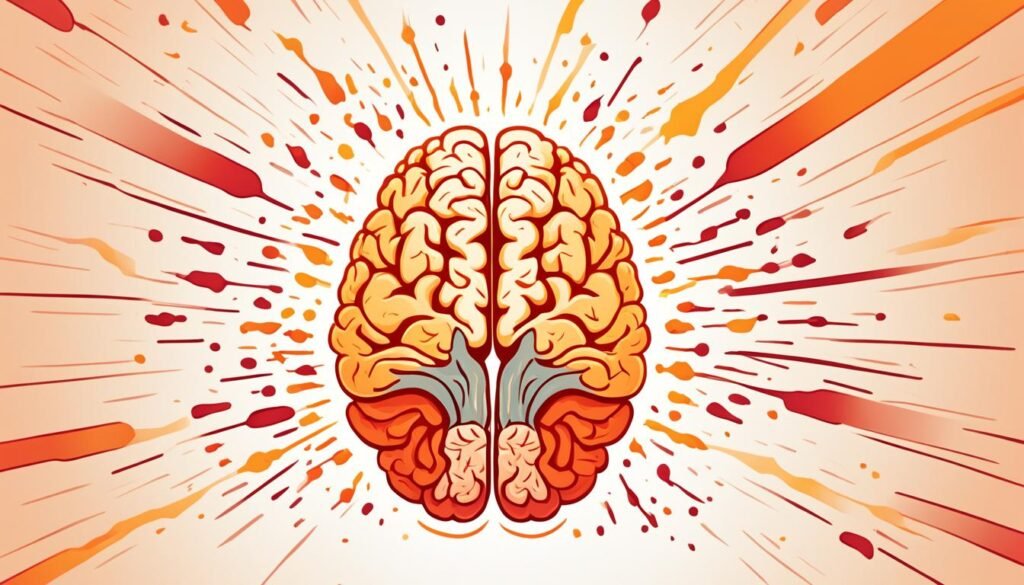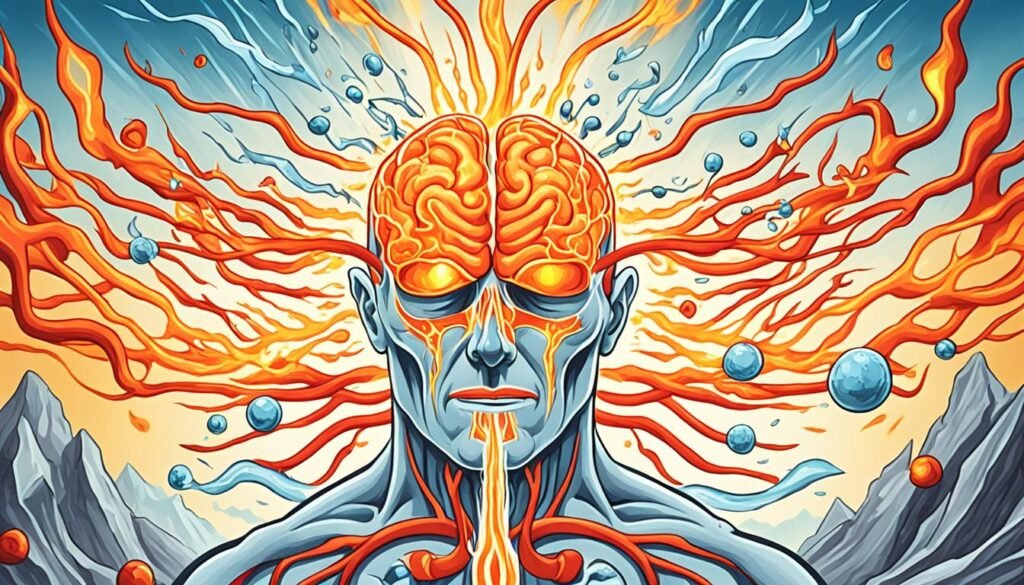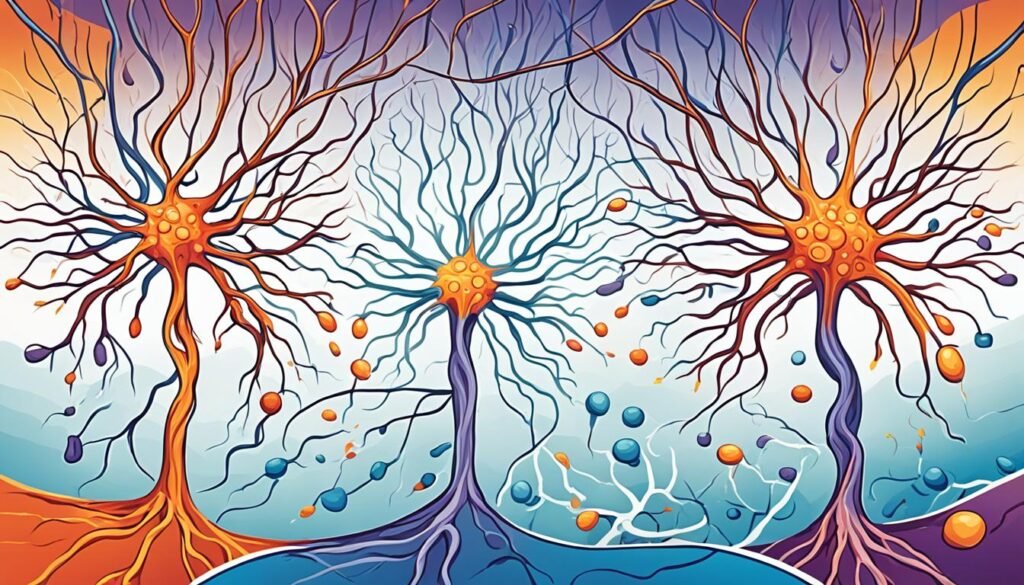Thalamic pain syndrome is a condition where you have long-lasting pain because of a brain injury like a stroke. This pain can be very intense and focused in one area. It may also cause your skin to feel things differently or make you more sensitive to pain and temperature changes.
After a stroke, this type of pain can show up even years later, making it hard to link back to the original injury. It’s known by other names, too. This pain comes from an issue in the brain that messes with how we feel things through touch. Dealing with this pain can be tough and affects how someone lives their life.
Treatment involves different methods and often a group of doctors working together. They use drugs, physical therapies, or even surgeries to help manage the pain. This shows how complex and challenging thalamic pain syndrome can be for those living with it.
Table of Contents
ToggleWhat is Thalamic Pain Syndrome?
Definition and Overview
Thalamic pain syndrome is a long-lasting pain disorder that comes after a stroke. The pain is typically focused and linked to changes in how the body senses temperature. Also, patients may feel more pain than usual or pain from things that are not normally painful.
Relationship with Central Post-Stroke Pain
It’s also known as central post-stroke pain today. But in the past, it was called Dejerine-Roussy syndrome. Not all central post-stroke pain comes from the thalamus though. This type falls under central post-stroke pain, which covers many kinds of pain after a stroke.

Causes of Thalamic Pain Syndrome
Thalamic pain syndrome often starts after a stroke, especially one that affects blood flow to the thalamus. When the thalamus lacks blood, an area might die (a lacunar infarct). Or, if the whole area is impacted by stroke, it’s named after the artery it involves, like an PCA infarction. Issues like abscesses can also trigger this pain.
Cerebrovascular Accidents (Strokes)
Strokes in the thalamus cause neuropathic pain. It can affect how you feel in the opposite part of your body and hurt your senses, including feeling temperature and pain. About 8% of stroke survivors face this pain, with 5% finding it quite severe. It’s more common in older adults, affecting roughly 11% of those over 80.
Thalamic Lesions and Injuries
Other problems in the thalamus, like abscesses, can also lead to this pain. For example, some strokes don’t always produce this syndrome. And the pain might happen right away or show up slowly over time after the stroke.
Epidemiology of Thalamic Pain Syndrome
Prevalence after Stroke
After a stroke, about 8% of people may develop thalamic pain syndrome. Thalamic strokes cause 20% to 33% of the pain cases after a stroke. This pain usually appears as people recover from a brain attack.
Age and Gender Factors
Up to 8% of those who have had a stroke might face post-stroke pain. This number rises to 11% for those over 80. Although some studies show that younger stroke survivors are more prone to pain, this theory isn’t always proven.
Symptoms of Thalamic Pain Syndrome
People with thalamic pain syndrome face many severe symptoms. These symptoms can really change their daily life. It’s important for doctors to know about these signs to help their patients better.
Centralized Neuropathic Pain
The main sign is intense, centralized neuropathic pain. This pain is often described as a burning or tearing feeling. It can also cause sudden bursts of pain or a pins and needles sensation. The pain usually happens on the opposite side of the body from where the thalamic injury is.
Hyperalgesia and Allodynia
Severe pain isn’t the only issue. There’s also hyperalgesia and allodynia. Hyperalgesia means the person feels more pain than usual from something painful. Allodynia is when things that shouldn’t hurt, like a light touch, do cause pain. These problems can add to the person’s suffering and make everyday tasks very hard.
Temperature Changes and Autonomic Instability
Another symptom is changes in skin temperature and autonomic instability. The skin might feel like it’s burning or be cold and damp. This issue with temperature and how the body works comes from the thalamic injury’s effect on sensory processing.

Pathophysiology of Thalamic Pain Syndrome
Thalamic pain syndrome is a unique type of centralized pain. It starts in the central nervous system. The condition leads to central sensitization. This means the nervous system is always very active. As a result, the patient’s body becomes super sensitive to pain. This amplification of pain signals is called the “wind-up” phenomenon.
One of the main causes of this syndrome is damage to the spinothalamic tract. This tract carries sensory data from the body to the thalamus. Damage to this pathway, especially in the ventral posterior nuclei, is common in thalamic pain syndrome. A decrease in opiate receptors in the affected area also makes pain feel stronger in such cases.

Diagnosis of Thalamic Pain Syndrome
Diagnosing thalamic pain syndrome can be tough. Symptoms often start showing up late after a stroke. The doctor will ask about the patient’s stroke history and the pain’s details. This includes where it hurts, how it feels, and any other symptoms.
Medical History and Physical Examination
A careful physical and nerve check is key. The doctor looks for signs like not feeling touch or pain right. This could mean thalamic pain syndrome is the cause.
Diagnostic Imaging and Tests
Tests like MRIs or CT scans are used to see thalamic lesions. These images help find out if thalamic pain syndrome is the reason for the patient’s symptoms. They also help rule out other causes.

Treatment Options for Thalamic Pain Syndrome
Dealing with thalamic pain syndrome can be tough. This condition often doesn’t respond well to treatments. Yet, doctors have many ways to help ease the severe and long-lasting pain it causes.
Pharmacological Treatments
Medicines play a big role in treating this kind of pain. Doctors might try drugs that treat nerve pain, like gabapentin and pregabalin, or those that help with mood, like tricyclic antidepressants. Lidocaine patches and creams, which are applied to the skin, could also help. But, some patients might need opioid painkillers, though these are only used short-term due to their risks.
Non-Pharmacological Treatments
Not all treatments involve medicine. Therapy can also be very helpful. Physical and occupational therapies might boost movement and lessen sensory problems. Alternative treatments like acupuncture and a therapy called TENS show some good results too.
Invasive Treatments
For the toughest cases, more extreme options might be on the table. These can include surgeries like deep brain stimulation, using electrodes in the brain, or spinal cord stimulation, which blocks pain messages. For a select few, a surgery to remove or destroy parts of the thalamus might be considered.
A team approach is key for best managing thalamic pain syndrome. Specialists from different fields, including neurologists and surgeons, should work together. This ensures the patient gets a treatment plan that considers all aspects of their condition.
Prognosis and Quality of Life
For patients with thalamic pain syndrome, the outlook is uncertain. This condition can greatly affect a person’s quality of life. The severe pain is hard to handle and often doesn’t get better with available treatments. This can lead to ongoing suffering and many challenges in daily life.
Despite trying many treatment methods, managing thalamic pain syndrome remains a big challenge. The condition negatively affects the patient’s body, mind, and how they interact with others. This means it can affect all parts of their life, not just their physical health.
Living with Thalamic Pain Syndrome
Living with thalamic pain syndrome is tough for both patients and their families. The pain is constant and can harm your mental health. This makes things difficult, but there are ways to manage the struggles.
Coping Strategies
Doing gentle exercises and low-impact activities can reduce the pain. They also boost your well-being. Relaxation methods like deep breathing, meditation, and yoga help lower stress. They handle the emotional side of thalamic pain syndrome. Joining support groups or getting counseling offer emotional support and tips to face this condition.
Support Resources
Connecting with local and national groups for neuropathic pain is helpful. These groups offer information, link you to healthcare services, and connect you with others who understand. StrokeLine, for example, supports those with thalamic pain syndrome.
By using good coping methods and seeking support, you can lessen the impact of thalamic pain syndrome. Remember, there’s a whole community ready to help you through these tough times.
Thalamic Pain Syndrome Complications
Thalamic pain syndrome can cause several issues that greatly affect your life. You might face problems like not being able to control your body temperature, your body acting unpredictably, and altered senses. These things can keep you from doing regular activities, going out with friends, and feeling good.
If you have [thalamic pain syndrome complications], you could also be more likely to become depressed or anxious. This happens because the pain is so bad and it stops you from doing what you want. It can really hurt your feelings and how you think about things.
To better your life, it’s very important to deal with these complications from thalamic pain syndrome. Doctors should make a plan with you. This plan should help with not just the physical pain but also with how you’re feeling and thinking.
Preventive Measures for Thalamic Pain Syndrome
Thalamic pain syndrome mainly comes from strokes. So, the top ways to stop it are by avoiding strokes. This means changing your lifestyle and getting the right medical help. You should manage things that up your stroke odds, like high blood pressure, diabetes, and high cholesterol. Also, eat healthy, exercise often, and put down smoking.
If you have a stroke or a nerve injury, quick and good care can lower the chance of getting thalamic pain syndrome. But, it’s hard to prevent because its signs might not show right after a stroke. You need to take care of your heart health and get help fast if you think something is wrong.
Working with your doctor and taking these steps can lower your chances of getting thalamic pain syndrome. Remember, it’s all about acting early and focusing on stopping strokes. This is key to avoid this tough condition.
Research and Clinical Trials
There’s still a lot we don’t know about thalamic pain syndrome. So, more research and clinical trials are needed. Scientists are diving deep into what causes it and how to treat it better. They are looking into new drugs, ways to change nerve activity, and other treatments.
In 2013, Minella and others checked how often people got thalamic pain after a stroke in Italy. Meanwhile, in 2014, Harno looked at young stroke sufferers in Finland. MacGowan studied the special type of stroke causing the pain back in 1997.
Some studies have tested different treatments. For example, Leijon and Boivie looked into using two medications to ease the pain in 1989. Nasreddine and Saver focused on why pain happens more on one side of the brain in 1998. And Bowsher and team checked how often the pain matched up with brain scans in 1998.
The aim of all this research and testing is to make life better for those with thalamic pain. Learning more and trying new treatments can hopefully lead to better care. This could really help the people suffering from thalamic pain syndrome.
Interdisciplinary Team Approach
Thalamic pain syndrome is a complicated condition. It needs a team of healthcare experts to handle it. This team approach is the best way to care for those with thalamic pain.
Role of Neurologists
Neurologists are key in figuring out thalamic pain syndrome. They take a full medical history and do a physical check-up. They also order tests like neuroimaging. This helps find the cause of the pain so treatment can start.
Role of Pain Medicine Specialists
Pain doctors help make a complete treatment plan for thalamic pain. They mix different ways to manage pain. This includes medicine and other methods. Their goal is to give patients relief from the constant pain.
Role of Neurosurgeons
Sometimes, surgery is needed for thalamic pain syndrome. Neurosurgeons help with these more advanced treatments. They work with the team to decide what’s best for the patient. Their skills are important in treating this complex condition.
The work of neurologists, pain medicine specialists, and neurosurgeons is vital. Together, they offer the best care and outcomes for those with thalamic pain syndrome.
Conclusion
Thalamic pain syndrome is a tough neuropathic pain condition. It usually pops up after strokes in the thalamus. This problem brings intense pain, changes in how you feel temperature, and problems with touch. It makes life very hard for those it affects. Thalamic pain syndrome happens often, in around 8% of stroke cases. But, it’s not easy to spot and treating it isn’t easy either.
A group effort by doctors who are experts in different fields is key. They include neurologists, pain experts, and neurosurgeons. Together, they work to help patients and find new ways to heal. Knowing the facts about thalamic pain syndrome helps doctors do better. They can find it faster, start the best treatments, and help their patients feel better.
With thousands of people facing central post-stroke pain, the need for more research and better treatments is clear. By keeping up with new info and methods, you’re helping. You’re part of making things better for those fighting thalamic pain syndrome.
FAQ
What is thalamic pain syndrome?
How is thalamic pain syndrome related to central post-stroke pain?
What are the common causes of thalamic pain syndrome?
How prevalent is thalamic pain syndrome after a stroke?
What are the main symptoms of thalamic pain syndrome?
How is thalamic pain syndrome characterized from a pathophysiological perspective?
What are the challenges in diagnosing thalamic pain syndrome?
What are the treatment options for thalamic pain syndrome?
What is the prognosis and impact on quality of life for patients with thalamic pain syndrome?
What are some coping strategies and support resources for individuals living with thalamic pain syndrome?
What are the potential complications of thalamic pain syndrome?
How can the development of thalamic pain syndrome be prevented?
What is the current state of research and clinical trials for thalamic pain syndrome?
How do different healthcare professionals contribute to the management of thalamic pain syndrome?
Source Links
- https://www.ncbi.nlm.nih.gov/books/NBK554490/
- https://www.ncbi.nlm.nih.gov/pmc/articles/PMC2670809/
- https://en.wikipedia.org/wiki/Dejerine–Roussy_syndrome
- https://link.springer.com/10.1007/978-0-387-79948-3_802
- https://radiopaedia.org/articles/dejerine-roussy-syndrome-1?lang=us
- https://www.mdpi.com/2075-4418/12/6/1439
- https://www.ncbi.nlm.nih.gov/pmc/articles/PMC9222201/
- https://strokefoundation.org.au/what-we-do/for-survivors-and-carers/after-stroke-factsheets/pain-after-stroke-fact-sheet

Best Neurologist Doctor In Patna: Dr Chandril Chugh Dedicated to Your Well-being
Dr.Chandril Chugh is a neurologist who trained and practiced in the USA for more than a decade. He is compassionate and caring and is most well known for being a patient listener and spending ample time with patients.
